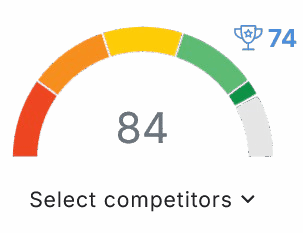With Neuronwriter SEO, you boost your visibility by using NLP-based keyword optimization that matches search intent and semantic relevance. You’ll analyze competitor content to spot gaps and improve your topic authority, while smart internal linking guides visitors and search engines through your site. Tracking performance metrics helps you fine-tune strategies and apply on-page SEO tweaks for better readability. If you want a deeper understanding of these effective tactics, there’s more to explore ahead.
Key Takeaways
- Utilize NLP-based keyword optimization to target semantic relevance and user intent effectively with long-tail and LSI keywords.
- Conduct competitor content analysis to identify gaps, replicate top formats, and enhance content authority and engagement.
- Implement strategic internal linking with descriptive anchors to guide user journeys and improve site architecture clarity.
- Monitor SEO metrics regularly, including keyword density, CTR, and readability, for continuous content refinement and visibility boost.
- Create clear, actionable content with real-world examples and semantic terms to deepen engagement and establish topical authority.
Leveraging NLP-Based Keyword Optimization for Better Rankings

When you leverage NLP-based keyword optimization, you tap into a smarter way to improve your rankings by targeting semantic relevance and search intent more effectively.
Using NLP tools, you can identify long-tail and LSI keywords that reflect what your audience truly seeks, allowing you to serve their needs more precisely. This is crucial for enhancing topical authority and ensuring your content resonates with users’ search queries.
Keyword clustering helps you group related terms, enriching your content’s depth without stuffing. This approach naturally integrates relevant concepts, making your content more valuable and thorough. Additionally, incorporating internal and external links strategically enhances content structure and user experience.
By balancing keyword frequency and placing primary keywords strategically—like in your meta titles and first 100 words—you guarantee clarity and relevance.
Ultimately, this thoughtful optimization supports your mission to provide meaningful, accessible information that genuinely benefits your visitors.
Analyzing Competitor Structures to Improve Content Quality
How do top competitors structure their content to captivate readers and rank higher?
By conducting thorough competitor analysis, you can uncover how they balance style, depth, and formatting to engage audiences effectively. NeuronWriter provides comprehensive analysis that can help you identify these successful strategies.
Use content mapping to evaluate their heading hierarchies, multimedia use, and keyword coverage, revealing opportunities to improve your own material’s clarity and richness. Regularly performing a competitive content analysis ensures your strategy remains up to date and aligned with industry standards.
Spot content gaps by identifying unaddressed subtopics or underused multimedia that your competitors overlook.
Assess their CTA placements and engagement drivers to serve your audience better with purposeful calls-to-action.
By replicating top-performing formats and refining your structure based on competitor insights, you’ll enhance your content quality and authority. This thoughtful competitor analysis and content mapping guarantees you build helpful, well-organized content that truly meets your readers’ needs.
Implementing Effective Internal Linking Strategies

Analyzing competitor content structures gives you valuable insights, but turning those insights into action requires smart internal linking strategies.
Internal linking not only supports search engines in understanding your site’s architecture but also guides your visitors through meaningful user journeys. They also enhance crawl efficiency by helping crawlers discover new and updated content. Effective internal linking can significantly improve user experience, making it easier for visitors to navigate your site.
To serve your audience best, focus on these key steps:
- Build clear pathways by linking from broad informational pages to more specific, transactional ones to enhance user journeys.
- Use descriptive anchor text to provide context and encourage clicks.
- Connect related content to reduce bounce rates and increase time spent exploring your site.
- Guarantee link accessibility and crawlability to help search engines index your pages efficiently.
Identifying and Filling Content Gaps for Topical Authority
To establish topical authority, you need to identify and fill content gaps that your competitors overlook or underutilize. Use SEO tools to compare your content alignment with audience targeting, focusing on high-intent search queries your site misses. Prioritize gaps validated by search volume, and consider various content formats audiences prefer. This approach helps you serve your audience better by addressing their specific needs thoroughly. NeuronWriter analyzes existing content to provide actionable insights, enhancing your ability to fill these gaps. Measuring topical authority is essential because it allows you to track how well your content establishes expertise and aligns with search intent.
| Content Gap Type | Strategy | Benefit |
|---|---|---|
| Keyword Coverage | Use Ahrefs to find missing terms | Capture untapped traffic |
| Audience Intent | Target high-intent queries | Align content with user needs |
| Content Formats | Add videos, infographics | Engage diverse audience types |
| Buyer Journey Stage | Match content to journey phases | Guide users effectively |
Filling these gaps reinforces your topical authority and improves visibility.
Monitoring SEO Performance Metrics to Refine Strategies

After identifying and filling content gaps, you need to keep a close eye on SEO performance metrics to fine-tune your strategy.
Regular keyword tracking helps you maintain ideal density and avoid overstuffing, ensuring your content stays relevant and reader-friendly. Conducting frequent content audits lets you spot areas needing improvement, like outdated information or weak headings. Additionally, leveraging AI content generation can help create drafts that are more aligned with SEO best practices.
Here’s how you can refine your approach:
- Monitor click-through rates and readability scores to enhance user engagement.
- Compare your content scores with competitors to discover new opportunities.
- Adjust keyword frequency and heading structures based on performance insights.
- Use NLP-driven semantic analysis to enrich content with related terms and natural questions. Incorporating content scoring tools can provide actionable recommendations tailored to your content’s SEO readiness, helping to prioritize improvements effectively.
Applying On-Page SEO Adjustments for Enhanced Readability
When you apply on-page SEO adjustments, you make your content easier to read and engage with, which keeps visitors on your site longer.
To serve your audience well, focus on readability techniques like using short sentences, simple language, and a conversational tone.
Organize your content formatting thoughtfully—break text into shorter paragraphs, use clear headlines and subheadings, and add bullet points to improve scannability. This structured approach enhances navigation and understanding, demonstrating effort in content creation. Incorporating SEO recommendations from tools like NeuronWriter can further refine your content strategy.
This approach reduces cognitive load and helps readers quickly grasp your message.
Including real-world examples and step-by-step guides also boosts clarity and actionability.
By cutting unnecessary fluff and structuring your content logically, you create a welcoming experience that supports your visitors’ needs while enhancing your SEO visibility.
These adjustments empower you to connect more effectively with those you serve.
Utilizing Semantic Term Suggestions to Boost Content Relevance

Although crafting keyword-rich content is essential, you’ll boost relevance even more by utilizing semantic term suggestions that align with user intent and search engine expectations.
Semantic search helps you understand query variations and improves term relevance through contextual keywords. To serve your audience best, focus on:
- Using tools like SEMrush for keyword clustering to organize related terms logically.
- Analyzing Google’s “People Also Ask” to capture user intent and expand content discovery.
- Mining competitor content for missing semantic terms that enhance audience engagement.
- Incorporating user-generated insights from forums and support tickets to reflect authentic language. This approach not only improves content depth but also establishes topical authority by covering comprehensive sub-topics within your niche. Moreover, leveraging built-in SERP tracking can help you monitor the effectiveness of these strategies and provide insights for continuous improvement.
Frequently Asked Questions
How Does Neuronwriter Integrate With Other SEO Tools?
You’ll love how Neuronwriter’s API integration guarantees smooth tool compatibility, letting you connect with platforms like Google Search Console and WordPress. This helps you serve clients better by streamlining workflows and sharing valuable SEO insights effortlessly.
Can Neuronwriter Optimize Content for Voice Search?
You might wonder if NeuronWriter can truly boost your voice search content optimization. It does, by guiding you to use natural language, questions, and semantic terms that help your audience find and understand your content effortlessly.
What Training Resources Are Available for New Neuronwriter Users?
You’ll find user guides and tutorial videos that walk you through NeuronWriter step-by-step. These resources empower you to serve others better by mastering content optimization, competitor analysis, and SEO strategies with confidence and clarity.
Does Neuronwriter Support Multiple Languages for SEO?
While NeuronWriter doesn’t fully embrace multilingual support, you can still benefit from its language optimization features. It gently assists you in crafting content that serves diverse audiences, though specialized multilingual tools might be needed for deeper SEO needs.
How Does Neuronwriter Handle SEO for E-Commerce Websites?
You’ll boost e-commerce optimization by crafting tailored product descriptions with Neuronwriter. It suggests keywords, generates localized content, and automates SEO elements, helping you serve customers better and increase your online store’s visibility effortlessly.
Conclusion
By using NeuronWriter SEO, you can boost your content’s visibility considerably. Did you know that pages optimized with NLP-based keyword strategies see up to a 30% increase in organic traffic? By analyzing competitors, filling content gaps, and refining internal links, you’ll strengthen your site’s authority and rankings. Keep monitoring your SEO metrics and applying on-page improvements to stay ahead. With NeuronWriter, you’re equipped to make smarter, data-driven SEO decisions that truly deliver results.
References
- https://optiwebdesign.com/2024/10/23/advanced-techniques-in-neuronwriter/
- https://neuronwriter.com/blog/optimizing-seo-content-with-nlp-a-content-strategy-with-neuronwriter/
- https://www.tinylevermarketing.com/blog/what-is-neuronwriter-and-how-to-use-it
- https://www.youtube.com/watch?v=zAXWIEvNKUE
- https://neuronwriter.com
- https://optiwebdesign.com/2024/10/19/best-neuronwriter-ai-settings-for-seo-content/
- https://www.youtube.com/watch?v=KtcTMg-zAnU
- https://www.clearscope.io/blog/competitive-content-analysis
- https://surferseo.com/blog/competitor-content-analysis/
- https://marketinginsidergroup.com/search-marketing/how-to-perform-an-seo-competitor-analysis-tools-and-techniques/


